| AUTHORS |
TITLE |
BOARD # |
SESSION |
|
Nithum Thain, Aldo Crossa , Barun Mathema, Ted Cohen, Leonid Chindelevitch
|
StackTB: a machine learning-based method for classifying TB strains from MIRU-VNTR data |
1 |
A |
Cancelled
Olaitan Awe, Angela Makolo and Segun Fatumo |
The Interrelationships Between Ebola and Lassa virus: A Comparative Genomics Perspective
|
2 |
B |
| Jiun Yen, Glenda Gillaspy and Ryan Senger |
A genome-scale algorithmic approach for metabolic engineering of plants |
3 |
A |
| Waldo Acevedo, Danilo González and Eduardo Agosin |
Docking and Molecular Dynamics Studies on the Interaction of Steviol Glycosides with Human Bitter Taste Receptors
|
4 |
B |
| Waldo Acevedo, Danilo González and Eduardo Agosin |
Docking and Molecular Dynamics Studies on the Interaction of Non-caloric Sweeteners with Human Sweet Taste Receptor
|
5 |
A |
| Armin Rouhi, Janneke Wit and James Wasmuth |
Investigating the usefulness of long-read sequencing technologies on the study of large eukaryotic gene families |
6 |
B |
Cancelled
Robert Flight and Hunter Moseley |
Visualizing the Effects of Data Transformations on Errors |
7 |
A |
| Jeremy Cox, Richard Ballweg, Prakash Velayutham, David Haslam and Alexey Porollo |
An Accurate RNAseq-based Protocol for Metagenomic Taxonomy Classification |
8 |
B |
| Valeriia Sherina and Matthew McCall |
Modeling of non-detects in qPCR |
9 |
A |
| Dirk Bullock |
Statistical Analysis of Differential Gene Expression in Spinal Nerve Ligated Rats using RNA-seq
|
10 |
B |
| Albi Celaj, Nozomu Yachie, Louai Musa, Minjeong Ko, Marinella Gebbia, Shijie Zhou, Benjamin Grys, Tina Sing, Tiffany Fong and Frederick Roth |
Widespread complex genetic bases of ABC transporter mediated drug resistance in S. cerevisiae revealed through an engineered population profiling strategy |
11 |
A |
| Khadija El Amrani, Nancy Mah, Miguel Andrade-Navarro and Andreas Kurtz |
Gene expression profile based sample classification
|
12 |
B |
| Devendra Biswal, Manish Debnath, Ruchishree Konhar, Jean Valrie and Pramod Tandon |
Age estimation for the genus Cymbidium (Orchidaceae: Epidendroideae) with implementation of fossil data calibration using molecular markers (ITS2 & matK) and phylogeographic inference from ancestral area reconstruction. |
13 |
A |
| Devendra Biswal, Manish Debnath, Srinivasan Ramachandran, Anupam Chatterjee and Veena Tandon |
Ancestral area reconstruction and genetic variation of Paragonimus westermani (Trematoda: Digenea) and its position within the genus Paragonimus: an in silico study using ITS2 and COXI sequences
|
14 |
B |
| Ruipeng Lu and Peter K. Rogan |
Predicting cis-regulation in human promoters by information density-based clustering of heterotypic transcription factor binding sites
|
15 |
A |
| Jean-Michel Garant, Michelle S. Scott and Jean-Pierre Perreault |
Towards better identification of potential RNA G-Quadruplexes using machine learning
|
16 |
B |
| Vincent Boivin, Sonia Couture, Sherif Abou Elela and Michelle Scott |
Finding novel tragets of snoRNAs influencing alternative splicing and gene expression.
|
17 |
A |
| Kimberly MacKay, Zoe Gillespie, Brett Trost, Christopher Eskiw and Anthony Kusalik |
Computational Prediction of Key Transcription Factors Involved in Regulating the Cellular Response to Rapamycin
|
18 |
B |
| Nathaniel Bryans, Chenzhe Qian and A.P. Jason de Koning |
Advances in Detecting Convergent Sequence Evolution at Phylogenomic Scales
|
19 |
A |
| Larisa Fedorova, Alexei Fedorov, Rajib Dutta, Shuhao Qiu and Ahmed Al-Khudhair |
Cryptic Genetic Relatedness Among 1000 Human Genomes
|
20 |
B |
| Prabhjeet Basra, Gabriela Bernal-Astrain and Alex Wong |
Covariation between rates of substitution and levels of quinolone resistance in clinical isolates of Escherichia coli
|
21 |
A |
| Fazle Faisal and Tijana Milenkovic |
Novel strategies for dynamic analysis and alignment of biological networks and their interdisciplinary applications
|
22 |
B |
| Frances Hauser, Portia Tang, Ryan Schott, Gianni Castiglione, Alexander Van Nynatten, Elise Heon and Belinda Chang |
Application of codon-based evolutionary models in the prediction and validation of pathogenic mutations
|
23 |
A |
| Sonja Dunemann, Matthew Workentine, Cameron Goater, John Gilleard, James Wasmuth and Doug Colwell |
An -omics approach to improve diagnosis and treatment of the lancet liver fluke
|
24 |
B |
| Pamela Wu and David Fenyo |
Deciphering epigenetic signatures underlying coding status and cell-type specificity |
25 |
A |
| Maureen Smith, Redmond Smyth, Roland Marquet and Max von Kleist |
MIMEAnTo– A bioinformatics tool to profile functional RNA |
26 |
B |
| Katie Ovens, Ian McQuillan, Patsy Gómez-Picos and Brian Eames |
Analysis of biclustering algorithms using high dimensional gene expression data from skeletal tissues |
27 |
A |
| Muhammad Ayaz Anwar and Sangdun Choi |
Complex-proficient while being signaling-deficient: insight into the effects of mutations on TLR4 function |
28 |
B |
Ben Busby
|
NCBI and Regional Data Science, Bioinformatics and Genomics Hackathons! |
29 |
A |
| Eric Ho |
Codon Usage Under the Lens of Machine Learning |
30 |
B |
| Matthew R. Weber, Zachary D. Stephens, Liudmila S. Mainzer, Matthew Hudson, B. F. Francis Ouellette and Morgan Taschuk |
Statistical Models to Capture Mutational Properties for NextGen Sequencing Data
|
31 |
A |
| Chacha Issarow |
Assessment of the vaccine on tuberculosis control using age-structured mathematical model |
32 |
B |
| Lihong Yin, Farahnaz Rahmatpanah, Michael McClelland, Dan Mercola, Jun Ye and Zhenyu Jia |
Identification of age associated differentially expressed genes in prostate cancer |
33 |
A |
| Shuying Sun and Xiaoqing Yu |
Challenges and opportunities of differential methylation identification using bisulfite sequencing data |
34 |
B |
| Amanda Ernlund and Shubha Dhage |
Redefining the breast tumor margin utilizing a computational genomic ruler of tumor and tumor-adjacent normal tissue |
35 |
A |
| Deena Gendoo, Alexandra Pandyra, Peter Mullen, Joseph Longo, Jenna van Leeuwen, Linda Penn and Benjamin Haibe-Kains |
Identification of Dipyridamole Analogues for the Treatment of Acute Myeloid Leukemia using Computational Pharmacogenomics Approaches |
36 |
B |
| Abraham Moller and Chun Liang |
Mapping environmental virus-host interactions in solar salterns through metagenomics |
37 |
A |
| Fabien Dupuis-Sandoval, Michelle Scott, Douglas Wu, Ryan Nottingham, Sherif Abou Elela and Alan Lambowitz |
Study of alternative snoRNAs characterization methods by deep sequencing
|
38 |
B |
| Daniel Morris, Ram Khattri, Stephanie Bilinovich and Thomas Leeper |
Fragment Warheads for Selective Drug Design against Bacterial Glutaredoxins |
39 |
A |
| Piyush Priya and Gitanjali Yadav Terpene |
Synthases: The Mechanistically Intriguing Family of Enzymes Generating the Enormous Terpenome |
40 |
B |
| Nil Sahin, Erin Styles, Adrian Verster, Quaid Morris and Brenda Andrews |
A Morphology Profile Pipeline for Genome-wide Screens in Saccharomyces cerevisiae |
41 |
A |
| Daniel Kurtz, Gregory Moyerbrailean, Allison Richards, Omar Davis, Chris Harvey, Adnan Alazizi, Donovan Watza, Yoram Sorokin, Nancy Hauff, Francesca Luca and Roger Pique-Regi |
Gene expression networks of transcriptional response to 78 cellular environment perturbations |
42 |
B |
Madara Hetti Arachchilage, Brett Lowden and Helen Piontkivska
|
Mapping multi-protein-interface-interaction network in HIV-1 pre-integration complex (PIC) |
43 |
A |
| Marilyn Hayden, Frank Drews and Lonnie Welch |
Next Generation Pathway Analysis: Increasing Sensitivity and Accuracy by Incorporating Regulatory Elements |
44 |
B |
| Kai Wang and Chun Liang |
CRF: a web server for detecting CRISPRs in microbe genome |
45 |
A |
| Alexandra Taraboletti and Leah Shriver |
Cuprizone intoxication perturbs central nervous system metabolism |
46 |
B |
| Yixun Li, Luis Rueda and Alioune Ngom |
Prediction of High-throughput Protein-protein Interactions Using Short Linear Motifs |
47 |
A |
| Ewy Mathe, Elizabeth Baskin and Senyang Hu |
Leveraging integrative gene expression and metabolomics analysis to define molecular cancer signatures
|
48 |
B |
| Shirley Hui, Asha Rostamianfar and Gary Bader |
Large-scale GWAS pathway analysis identifies several breast cancer susceptibility pathways |
49 |
A |
| Mehran Karimzadeh and Michael M. Hoffman |
Transcription factor expression and its effects on binding site occupancy and motif preference |
50 |
B |
| Seyed Ali Madani Tonekaboni, Laleh Soltan Ghoraie and Benjamin Haibe-Kains |
Identification of transcriptional patterns conserved across in vitro and in vivo cancer samples |
51 |
A |
| Lina Wadi, Mona Meyer and Jüri Reimand |
Dramatic impact of knowledge accumulation on pathway enrichment analysis |
52 |
B |
| Venkata Manem, Sadiq Saleh, Nicholas Bertos, Morag Park and Benjamin Haibe-Kains |
Using networks to identify key players in breast cancer microenvironment interactions |
53 |
A |
| Michael Dong and Nicholas Provart |
Protein-ligand interaction exploration based on proteome-wide tertiary structure prediction and further in vitro validation |
54 |
B |
| Ruth Isserlin, Mike Kucera, Veronique Voisin and Gary D. Bader |
Enrichment Map Pipeline– a set of Cytoscape apps to visualize, explore and summarize pathway enrichment results |
55 |
A |
| Peter Ulintz, Jeanne Geskes, Melissa Coon, Patricia Tamsen, Elizabeth Ketterer, Angela Chidester, Christopher Gates, Erika Koppe, Craig Johnson, Elena Stoffel, Richard McEachin and Robert Lyons |
Performance comparison of targeted gene panel sequencing technologies using several cancer sample types |
56 |
B |
| Nirvana Nursimulu, Swapna Seshadri and John Parkinson |
How to be a good parasite |
57 |
A |
| Zunping Luo, Lingdi Zhang, Pavitra Rao, Swapna Uplekar, Daniel Hupalo and Jane Carlton |
Genome Sequencing and De Novo Assembly of a Clinical Isolate of Plasmodium vivax Malaria from India Using the Oxford Nanopore MinION |
58 |
B |
| Shruti Srivastava, Derek McKay and James Wasmuth |
In-silico investigation of parasite proteomes to predict immune mimicking proteins |
59 |
A |
| Mohamed Helmy, Alexander Crits-Christoph, Omar Wagih and Gary Bader |
Can-VD: Data Standard and Online Resource for Reporting Mutations Impact on Cancer Protein Interaction Networks |
60 |
B |
| Joseph Haddad, Anthony Deeter, Zhong-Hui Duan and Timothy O'Neil |
Analysis of Parallel Bayesian Network Learning |
61 |
A |
| Olivia S. Hershey and Hazel A. Barton |
Starving in the Dark: The Impact of Ultra-Small Cells on a Groundwater Microbial Community |
62 |
B |
Cancelled
Minggao Liang, Liis Liis Uusküla-Reimand, Shiao Yuan Huang, Huayun Hou, Alejandra Medina-Rivera and Michael Wilson |
Dissecting the properties of spatially-coordinated combinatorial transcription factor binding using ChIP-exo and evolutionary conservation |
63 |
A |
| Monjur Morshed, Brian Ingalls and Silvana Ilie |
An efficient finite-difference strategy for sensitivity analysis of stochastic models of biochemical systems |
64 |
B |
| Fiona Whelan and Michael Surette |
sl1p: A computational pipeline for the processing and analysis of 16S rRNA microbiome sequencing data |
65 |
A |
Cancelled
Emilee Holtzapple, K. Wyatt McMahon, Lonnie Welch and Karen Coschigano |
RelA as a Potential Regulator of Inflammation and Tissue Damage in Streptozotocin-Induced Diabetic STAT5 Knockout Mice
|
66 |
B |
| Huayun Hou, Liis Uusküla-Reimand, Payman Samavarchi-Tehrani, Matteo Vietri Rudan, Minggao Liang, Jüri Reimand, Suzana Hadjur, Anne-Claude Gingras and Michael Wilson |
Topoisomerase II beta interacts with cohesin and CTCF at topological domain borders |
67 |
A |
| Swapna Seshadri, Zhongming Hu, Verena Brand, Xuejian Xiong, Michael E. Grigg, Andrew Emili and John Parkinson |
Applying a co-elution strategy to generate the first genome scale protein interaction network for T. gondii
|
68 |
B |
| Mary Halpin and Helen Piontkivska |
Mutation patterns in Ebola may shine light on future outbreaks |
69 |
A |
| Zhengdeng Lei, Mark Maienscheincline, Hong Hu, Pinal Kanabar, Morris Chukhman, George Chlipala, Neil Bahroos, Ankit Desai and Roberto Machado |
Identification of subtypes of sickle cell disease with different prognosis and severity
|
70 |
B |
| Kevin Ha, Benjamin Blencowe and Quaid Morris |
Systematic analysis of alternative polyadenylation regulatory mechanisms from RNA-Seq |
71 |
A |
| Kelly Boyd, Amanda Misch, Emma Highland, Catherine Putonti and Sushma Reddy |
Extracting more from transcriptomes: assessing their utility for comparative analyses across birds |
72 |
B |
| Chris Cremer and Quaid Morris |
Deconvolving gene expression profiles for tumor populations with prior frequency information |
73 |
A |
| Midhun Kathanaruparambil Sukumaran, Marc R. Roussel and Brian P. Ingalls |
A novel model reduction approach for the Chemical Master Equation |
74 |
B |
| Brian Powell |
Large Scale Analysis of Predicting Subcellular Locations of Proteins Represented by Chaos Game Theory |
75 |
A |
| Jeff Wintersinger, Amit Deshwar and Quaid Morris |
Scaling cancer subpopulation phylogeny reconstruction to thousands of tumors |
76 |
B |
| David Bujold |
GenAP: A computing platform for life sciences research |
77 |
A |
| Sebastian Raschka, Leslie A. Kuhn, Weiming Li, Mar Huertas and Anne M. Scott Screenlamp: |
Screenlamp: A software framework for hypothesis-driven ligand discovery based on virtual screening and machine learning |
78 |
B |
| Katherina Baranova, Eliseos Mucaki, Dimo Angelov, Dan Lizotte and Peter Rogan |
Cisplatin Response Prediction in Recurrent Bladder Cancer using Biochemically-inspired Machine Learning |
79 |
A |
| Alysha Cypher and Brian Bagatto |
Lipid composition and cardiovascular health of Danio rerio larvae with maternal and embryonic exposure to endocrine disruptors (EDs) |
80 |
B |
| Sreeskandarajan Sutharzan, Chun Liang and John Karro |
FindIR2: A MATLAB-based tool for accurate detection of imperfect inverted repeats in DNA sequences |
81 |
A |
| Brittany Baur and Serdar Bozdag |
Reverse engineering gene regulatory networks from structural and epigenetic data |
82 |
B |
| Ryan Schott, Daniel Gow and Belinda Chang |
RSAT: A toolkit for rapid generation and analysis of protein-coding sequence datasets |
83 |
A |
| Shagun Sharma, John Senko and Mathew Lee |
Comparision of Response of Pristine Soil Microbial Community to the Intrusion of Coal Mine-Derived Acid Mine Drainage from Two Different Sites |
84 |
B |
| Parisa Mazrooei, Tahmid Mehdi, Anna Goldenberg and Mathieu Lupien |
Identifying the role of noncoding single nucleotide variants (SNVs) on transcription factors activity in liver cancer |
85 |
A |
| Jennifer K. Holmes, Rachael A. Wasikowski, Michael W. Scott, Frank McFarland, Erich Grotewold, Andrea I. Doseff and John Gray |
Phylogenomic Analysis of the TRAF family of Co-regulators in Maize |
86 |
B |
| Mark Maienschein-Cline, Sophiya Karki, Zhengdeng Lei, Pinal Kanabar, George Chlipala, Hong Hu, Morris Chukhman, Neil Bahroos and Marcus Clark |
Single-cell RNA sequencing reveals allele-specific gene expression and rearrangement during V-J recombination |
87 |
A |
| Gungor Budak and Sarath Janga |
Seten: A tool for systematic identification and comparison of processes, phenotypes and diseases associated with RNA-binding proteins from condition-specific CLIP-seq profiles |
88 |
B |
| Nehme El-Hachem |
Decoding compound mechanism of action using integrative pharmacogenomics |
89 |
A |
| Virginia Saulnier, Alexa Badalamenti, Jeffrey Ng, Shyam Shah and Dr. Heather Wheeler |
Predicting Gene Regulation in Diverse Global Populations |
90 |
B |
| Mickaël Mendez, Eric G Roberts and Michael M Hoffman |
Semi-automated transcriptome annotation with SegRNA |
91 |
A |
| Beatriz E. Lujan-Toro, Connie Sauder, Owen Rowland and Sara L. Martin |
Whole Genome Assembly of Camelina microcarpa, a Resource for the Improvement of the Oilseed Crop Camelina sativa |
92 |
B |
| Prashant Kumar Kuntala |
Gene regulation in Chagas Disease |
93 |
A |
| Maureen Stolzer, Han Lai, Minli Xu, Rosanna G Alderson, Katherine Siewert and Dannie Durand |
NOTUNG-DM: Software for Reconstructing the Evolutionary History of Multidomain Proteins |
94 |
B |
| Seth Munholland, Claudia Dinatale and William Crosby |
Innovating Traditional de novo Genomics Tools to Overcome Traditional Requirements of High Power Computational Platforms Under Modern Financial Restrictions |
95 |
A |
| Claire Bertelli, Adrian C Lim, Gemma Hoad, Geoffrey L Winsor and Fiona S L Brinkman |
Enabling phyletic-based comparison and visualization of genomic islands for tens to hundreds of microbial genomes |
96 |
B |
| Laurynas Kalesinskas, Evan Cudone and Catherine Putonti |
S-plot 2.0: A computational tool for the rapid identification of horizontally acquired elements within genomic sequences |
97 |
A |
| Silva Konini, Jake O'Brien, Chun Peng and E J Janse van Rensburg |
Random Walk with Resistance and Solving Laplace’s Equation on MicroRNAs-Gene Interaction Networks |
98 |
B |
| Anthony Deeter, Joseph Haddad, Zhong-Hui Duan and Mark Dalman |
Inferring Genetic Interactions using PubMed |
99 |
A |
| Guenter Tusch, Shahrzad Eslamian, Krishna Nadiminti, Bhanu Yandrapragada and Raveena Pendyam |
Modeling Time Patterns in Gene Expression Profiling |
100 |
B |
| Pingzhao Hu, Yang Wang and Huyen Le |
Gene Set – based Deep Neural Network Learning for Disease Classification |
101 |
A |
| Christopher Cameron, Josée Dostie and Mathieu Blanchette |
Improved Hi-C Contact Maps by Adaptive Density Estimation |
102 |
B |
| Julie A. Shay, Claire Bertelli, Bhavjinder K. Dhillon and Fiona S.L. Brinkman |
The utility of draft bacterial genomes for gene function analysis and genomic island prediction |
103 |
A |
| Michael Levy, Kristin Kernohan, Yan Jiang and Nathalie Berube |
Regulation of genome-wide CTCF binding by MeCP2 |
104 |
B |
| George Chlipala, Ankur Naqib, Daniel May, Mark Maienschein-Cline, Pinal Kanabar, Zhengdeng Lei, Vincent Hu, Morris Chuckman, Orjala Jimmy, Stefan Green and Bahroos Neil |
Improving Taxonomic Annotation of 16S Amplicon Sequencing Data from Environmental Samples |
105 |
A |
| Elham Rezaei, Brett Trost, Daniel Hogan, Tony Kusalik, Alan Rosenberg and The Bbop Study Consortium |
Biologically-Based Approach to Evaluate Classification Criteria for Chronic Childhood Arthritis |
106 |
B |
Cancelled
Wei Pan |
Heterogeneity decreases diversity |
107 |
A |
| Laurynas Kalesinskas, Travis K Price, Evann E Hilt, Alan J Wolfe and Catherine Putonti |
Facilitating Comparative Genomic Analysis of Novel Microbes: Examination of Lactobacillus crispatus in the Female Urinary Microbiome |
108 |
B |
Cancelled
Chris Walsh |
Transcriptome analysis of diet indeed obesity in Zebrafish |
109 |
A |
| Majed Shaheen, Travis Price, Evann Hilt, Krystal Thomas-White, Alan Wolfe and Catherine Putonti |
Analyzing Bacteria within the Bladder Microbiota |
110 |
B |
| Farhad Maleki and Anthony Kusalik |
The Effect of Different Gene Set Scores on the Accuracy of Gene Set Enrichment Analysis Methods |
111 |
A |
| Kun Nie and Quaid Morris |
Computational analysis of target specificity of Drosophila double-stranded RNA-binding protein Staufen |
112 |
B |
| Rajneesh Srivastava, Gungor Budak and Sarath Chandra Janga |
Transcriptome analysis of developing lens reveals hundreds of novel transcripts and abundance of skipped exon as well as retained intronic splicing events |
113 |
A |
| Alexander Van Nynatten, Nathan R Lovejoy and Belinda Sw Chang |
Visual evolution in marine derived Amazonian fishes |
114 |
B |
| Morris Chukhman, Mark Maienschein-Cline, Pinal Kanabar, Cong Liu, George Chlipala, Zhengdeng Lei, Vincent Hu, Hui Lu and Neil Bahroos |
Heterogeneity Analysis of Gene Fusion in Glioblastoma |
115 |
A |
| Matthew Tuttle |
Gene Set enrichment analysis of leptinA (lepA) in the embryonic zebrafish |
116 |
B |
| Eduardo de Almeida Gutierrez and Belinda Chang |
Investigating the evolution of vision in Neotropical bats through comparative transcriptomics |
117 |
A |
| Alvin Farrel and Jun-Tao Guo |
Structure-based prediction of homeodomain binding specificity using homology models and an integrative energy function |
118 |
B |
| Tawny Cuykendall, In Sub Mark Han, Eric Minwei Liu and Ekta Khurana |
Predicting the functional indispensability of non-coding elements |
119 |
A |
| Jonathan Chen and Donald Visco Developing a virtual high-throughput screening pipeline for faster drug discovery: Cathepsin-L lead identification and confirmation |
Developing a virtual high-throughput screening pipeline for faster drug discovery: Cathepsin-L lead identification and confirmation |
120 |
B |
| Arnab Saha Mandal, Aaron Mathankeri and A.P. Jason De Koning |
TAIGA: A computational framework for predicting genotype to phenotype associations |
121 |
A |
| Han Lai, Minli Xu, Maureen Stolzer, Rosanna Alderson and Dannie Durand |
NOTUNG 2.8: A Reconciliation Engine for Phylogenomics |
122 |
B |
| Coby Viner, James Johnson, Nicolas Walker, Hui Shi, Marcela Sjoberg, David J. Adams, Anne C. Ferguson-Smith, Timothy L. Bailey and Michael M. Hoffman |
Modeling methyl-sensitive transcription factor motifs with an expanded epigenetic alphabet |
123 |
A |
| Ceth Parker, John Senko, Ira Sasowsky, Hazel Barton and Augusto Auler |
Cultivation of Iron Reducing Bacteria from Iron Ore Caves |
124 |
B |
| Kyle Smith, Vinod Yadav, Shanshan Pei, Dan Pollyea, Craig Jordan and Subhajyoti De |
SomVarIUS: Somatic variant identification from unpaired tissue samples |
125 |
A |
| Matthew Mccall, Helene McMurray, Anthony Almudevar and Hartmut Land |
Estimation of a Regulatory Network of Cooperation Response Genes in a Model of Cancer Malignancy |
126 |
B |
Pravin Kumar, Anurag Kumar, Devashish Das and Naveen Kulkarni
|
A Novel Quantitative Insilico Method to Delineate the Mechanism of Enzyme Specificity-Provide Insights for Enzyme Engineering |
127 |
A |
| Joachim von Wulffen, Andreas Ulmer, Oliver Sawodny and Ronny Feuer |
Gene-specific RNA elongation rates are different depending on the treatment triggering gene expression changes |
128 |
B |
| Helen Piontkivska, Abdul Haseeb, Mohammad Makki An and Tariq Haqqi |
miRNome profiling in human osteoarthritis: complexity of 3’ modifications |
129 |
A |
| Guangyan Zhou, Tim Geary, Mary Stevenson and Jianguo Xia |
Comprehensive transcriptome meta-analysis to characterize host immune responses in helminth infections |
130 |
B |
| Florian Goebels, Zoran Minic, Sadhna Phanse, Gary Bader and Mohan Babu |
Phosphoproteomic analysis on mitochondria isolated from differentiated human neuronal cells identifies new phosphorylation sites on proteins linked to neurodegenerative disorders |
131 |
A |
| Daniel Sánchez-Taltavull |
Optimal architecture of differentiation cascades with asymmetric and symmetric stem cell division |
132 |
B |
| Md Shihab Hasan, Martha Zakrzewski, Don McManus and Lutz Krause |
Machine learning approach for identifying parasite immunoreactive proteins: example driven by Schistosoma genomes |
133 |
A |
| Rahul Agarwal and Ashutosh Singh |
miCoRe: Colorectal Cancer miRNAs Database |
134 |
B |
| Ehsaneddin Asgari and Mohammad R.K. Mofrad |
Neural Network Word Embeddings of Biological Sequences with Applications in Deep Proteomics and Genomics |
135 |
A |
| Ahmed Elbassiouny, Ryan Schott, Belinda Chang and Nathan Lovejoy |
Genomic and Computational Approaches to Electrogenesis in Fishes |
136 |
B |
| Houxiang Zhu, Lauren Misel, Mitchell Graham and Chun Liang |
CT-Finder: A Web Service for CRISPR Optimal Target Prediction and Visualization |
137 |
A |
| Pingchuan Li, Sylvie Cloutier and Frank You |
RGAugury: A pipeline for genome-wide prediction of resistance gene analogs (RGAs) in plants |
138 |
B |
| Sarah Dungan and Belinda Chang |
Using ancestral sequence reconstruction methods to predict functional evolution in cetacean rhodopsin over a major evolutionary transition |
139 |
A |
| Chad Smithson and Chris Upton |
Base-By-Base v3: new tools for the comparative analysis of genomes |
140 |
B |
| Sergey Aganezov and Max Alekseyev |
Multi-genome Scaffold Co-Assembly Based on the Analysis of Gene Orders and Genomic Repeats |
141 |
A |
| Michele D'Agnillo, Iman Rezaeian, Alioune Ngom and Luis Rueda |
Machine Learning Approaches for Breast Cancer Subtypes Reveal Key Genes as Potential Biomarkers |
142 |
B |
| Travers Ching and Lana Garmire |
Pan-Cancer Analyses Reveal Long Intergenic Non-Coding RNAs Relevant to Tumor Diagnosis, Subtyping and Prognosis |
143 |
A |
| Sijia Huang and Lana Garmire |
Novel personalized pathway-based metabolomics models reveal key metabolic pathways for breast cancer diagnosis |
144 |
B |
| André M. Comeau, Gavin M. Douglas and Morgan Langille |
Integrated Microbiome Resource (IMR): Developing an Open and Streamlined Experimental and Analysis Pipeline for Microbiome Research |
145 |
A |
| Abed Alkhateeb, Iman Rezaeian and Luis Rueda |
Hierarchal Clustering based on Non-negative Matrix Factorization for Time Series transcriptomes profiles |
146 |
B |
| Asmaa Elzawahry, Tsuyoshi Takahashi, Sachiyo Mimaki, Eisaku Furukawa, Rie Nakatsuka, Isao Kurosaka, Takahiko Nishigaki, Hiromi Nakamura, Satoshi Serada, Tetsuji Naka, Seiichi Hirota, Tatsuhiro Shibata, Katsuya Tsuchihara, Toshirou Nishida and Mamoru Kato |
Genomics and transcriptomic analysis of imatinib resistance in gastrointestinal stromal tumor |
147 |
A |
| Gyeongmo Gu, Erkhembayar Jadamba and Miyoung Shin |
Computational drug repositioning through graph-based semi-supervised learning with genomic expression and drug-gene interaction network |
148 |
B |
| Jinwoo Kim, Hyunjung Lee and Miyoung Shin |
Inferring genes sensitive to severity of toxicity symptom |
149 |
A |
| Mrinalini Pandit, Mina Maleki, Nicholas J Carruthers, Paul Stemmer and Luis Rueda |
Prediction of Calmodulin-binding Proteins Using Canonical Motifs |
150 |
B |
| Andrew Low and Alex Wong |
CoDuMIMM: Coevolution Detection using Mutual Information and Mutational Mapping |
151 |
A |
| Ian Hsu and Alan Moses |
Modelling stochastic pulsatility of transcription factors in Saccharomyces cerevisiae |
152 |
B |
| Hong Hu, Mark Maienschein-Cline, Zhengdeng Lei, Pinal Kanabar, George Chlipala, Morris Chukhman, Neil Bahroos and David Everly |
Identification of haplotypes in HLA using genetic variant calling from amplicon NGS data |
153 |
A |
| Iman Rezaeian, Eliseos Mucaki, Katherina Baranova, Huy Pham Quang, Dimo Angelov, Lucian Ilie, Alioune Ngom, Luis Rueda and Peter Rogan |
Predicting patient outcomes of hormone therapy in the METABRIC breast cancer study |
154 |
B |
| Caressa Tsai, Taraneh Zarin and Alan Moses |
Selection on quantitative traits within intrinsically disordered protein regions preserves functional output of phosphorylation sites |
155 |
A |
| Louis Philip Benoit Bouvrette, Neal Cody, Julie Bergalet, Alexis Blanchet-Cohen, Xiaofeng Wang and Eric Lecuyer |
Systematic Characterization of Subcellular RNA Localization Through Fractionation-Sequencing |
156 |
B |
| Christopher Cameron, Maia Kaplan, Alexandre Drouin, François Laviolette and Mathieu Blanchette |
Linking Transposable Elements to Chromatin Architecture in Arabidopsis thaliana |
157 |
A |
| Jose Hector Galvez Lopez, Helen H. Tai, Martin Lague, Bernie Zebarth and Martina V. Stromvik |
The nitrogen responsive transcriptome in potato (Solanum tuberosum L.) reveals significant gene regulatory motifs |
158 |
B |
| Jeffrey Liu, Veronique Voisin, Changjiang Xu, Ruth Isserlin and Gary Bader |
A Comprehensive Map of Critical Pathways and Networks in Cancer Stem Cells |
159 |
A |
| Jeffrey Wong, Gary Bader, Igor Rodchenkov, Chris Sander, Emek Demir and Ethan Cerami |
Pathway Commons: Single Point of Access to Biological Pathway Information |
160 |
B |
| Patryk Skowron, Livia Garzia, Sorana Morrissy and Michael Taylor |
Convergent Evolution of Medulloblastoma Metastatic Tumors |
161 |
A |
| Yared Kidane |
In silico Discovery of Candidate Transcriptional Biomarkers for Ionizing Radiation |
162 |
B |
| Eric Marinier, Rahat Zaheer, Chrystal Berry, Kelly Weedmark, Michael Domaratzki, Philip Mabon, Natalie Knox, Aleisha Reimer, Morag Graham, The Lids-Ng Consortium and Gary Van Domselaar |
Neptune: Signature Discovery Software |
163 |
A |
| Todd Riley, Cory Colaneri, Brandon Phan, Aadish Shah and Pritesh Patel |
The Affinity Data Bank for biophysical analysis of regulatory sequences |
164 |
B |
| James Morton, Stefan Freed, Md Nafiz Hamid, Shaun Lee and Iddo Friedberg |
Mining for New Antimicrobials: Predicting Bacteriocin Gene Blocks |
165 |
A |
| Yichao Li, Rami Al-Ouran and Lonnie Welch |
Discovering regulatory elements in co-expressed genes |
166 |
B |
| Bachar Cheaib, Malo Le Boulch, Pierre-Luc Mercier and Nicolas Derome |
A Metagenomic perspective on the structure and function of Lake Microbial Communities exposed to toxic metal traces in short term evolution |
167 |
A |
| Alexandre Drouin, Sébastien Giguère, Maxime Déraspe, Mario Marchand, Jacques Corbeil and François Laviolette |
Set Covering Machines and Reference-Free Genome Comparisons Uncover Predictive Biomarkers of Antibiotic Resistance |
168 |
B |

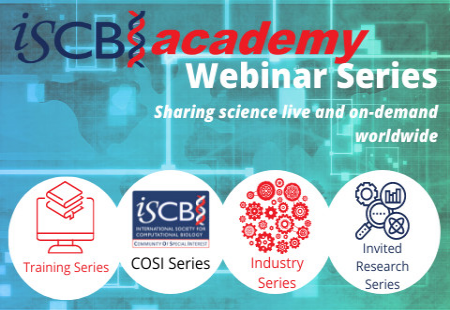

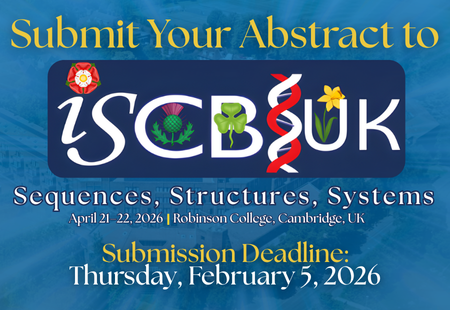
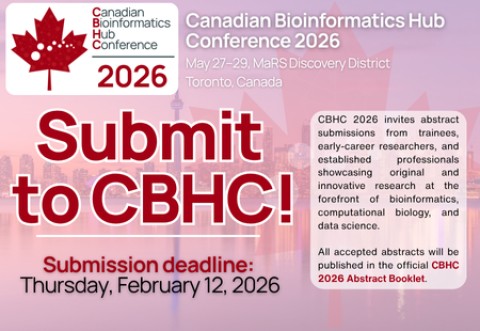
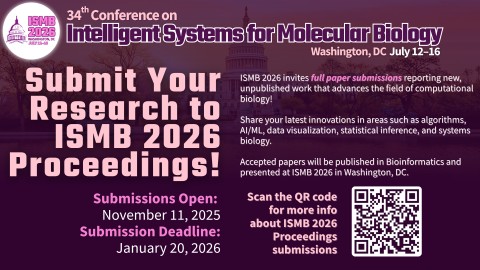
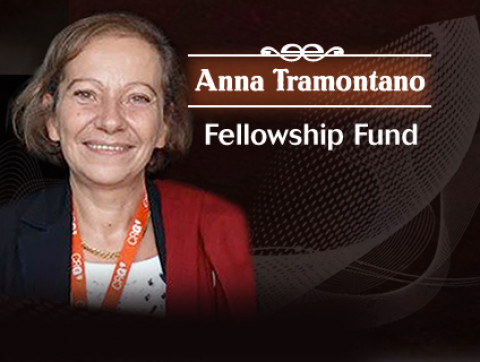
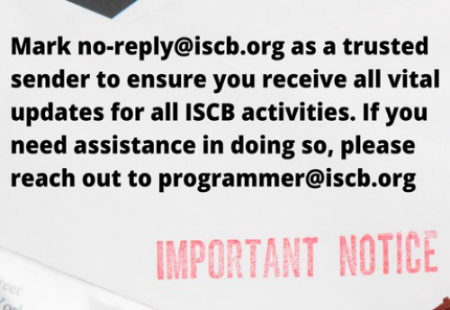















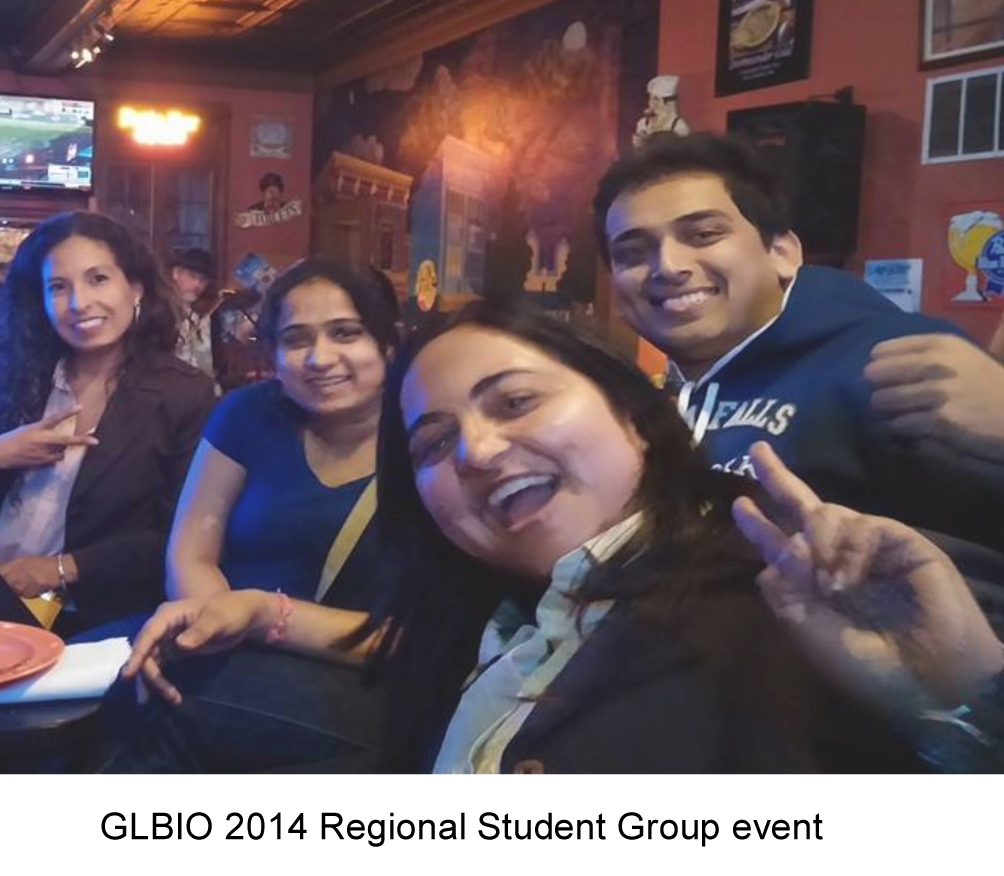
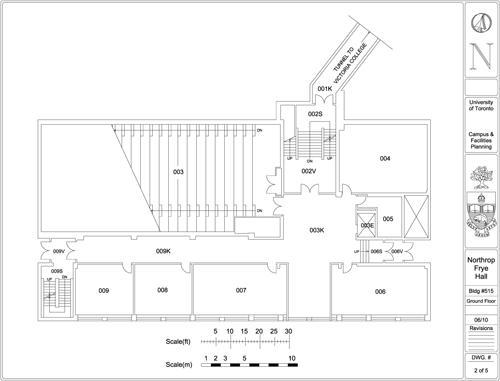
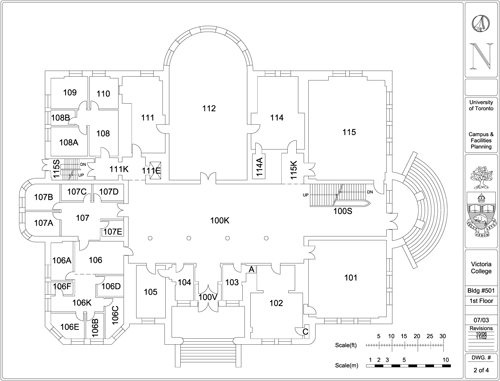
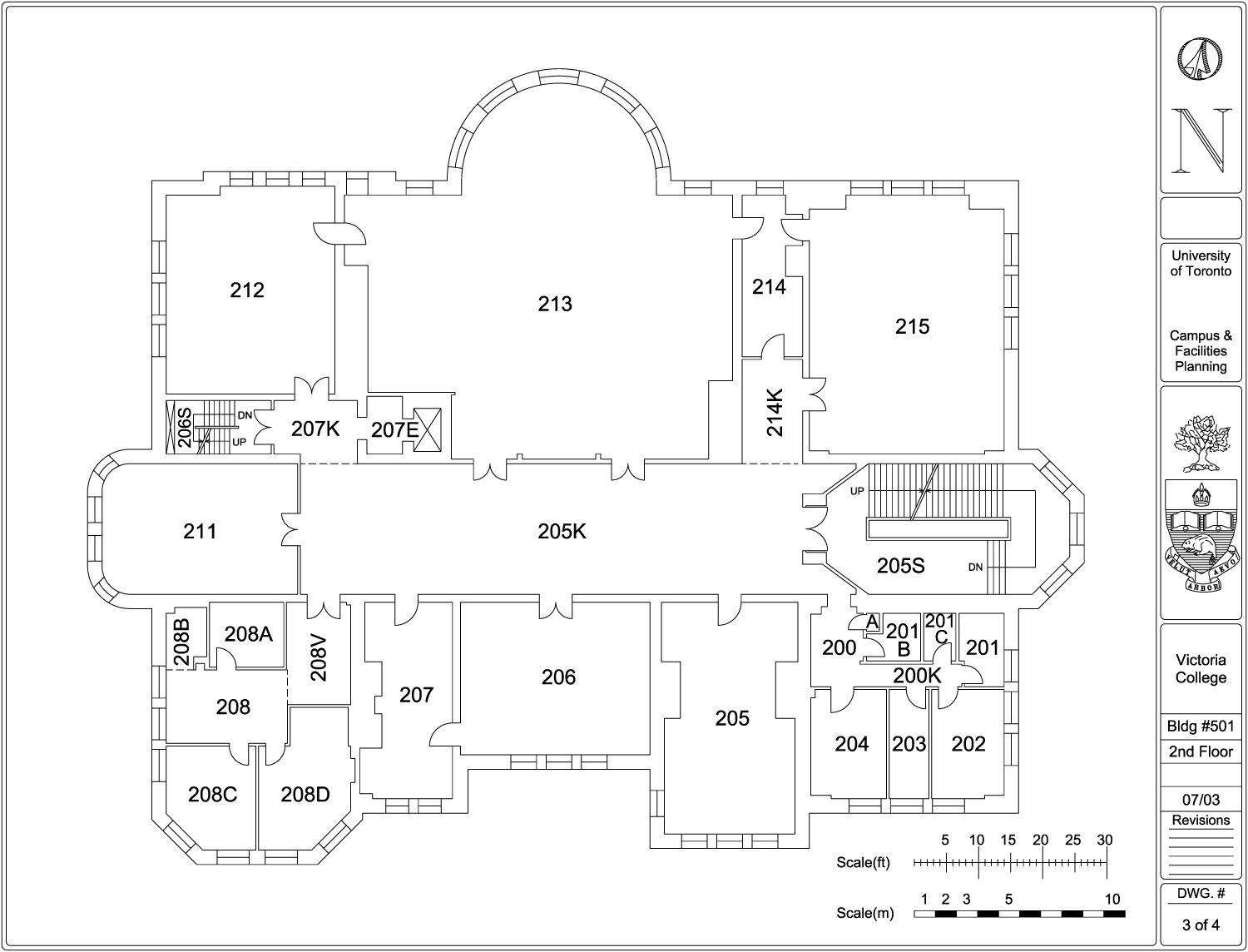
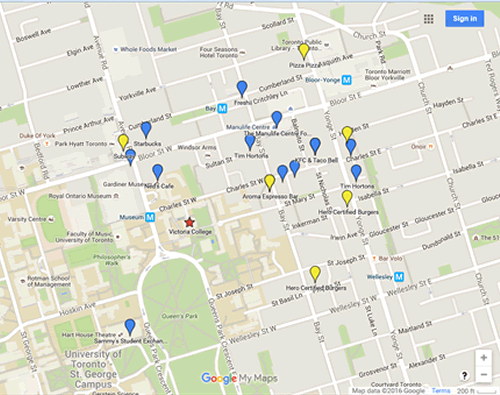
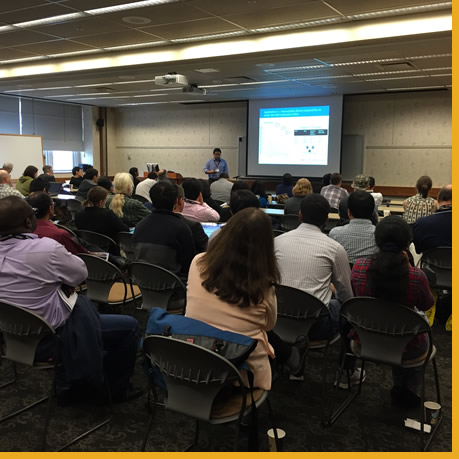 Full length papers and abstracts are solicited for oral and poster presentations at the 11th Great Lakes Bioinformatics Conference (an official conference of the International Society for Computational Biology) and 1st Canadian Computational Biology Conference. This call is an invitation to scientists and professionals working in the fields of bioinformatics and computational biology to submit high quality original research papers for presentation at GLBIO/CCBC 2016.
Full length papers and abstracts are solicited for oral and poster presentations at the 11th Great Lakes Bioinformatics Conference (an official conference of the International Society for Computational Biology) and 1st Canadian Computational Biology Conference. This call is an invitation to scientists and professionals working in the fields of bioinformatics and computational biology to submit high quality original research papers for presentation at GLBIO/CCBC 2016.



